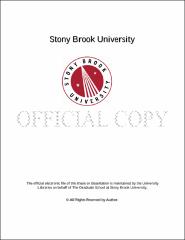| dc.identifier.uri | http://hdl.handle.net/11401/76220 | |
| dc.description.sponsorship | This work is sponsored by the Stony Brook University Graduate School in compliance with the requirements for completion of degree. | en_US |
| dc.format | Monograph | |
| dc.format.medium | Electronic Resource | en_US |
| dc.language.iso | en_US | |
| dc.publisher | The Graduate School, Stony Brook University: Stony Brook, NY. | |
| dc.type | Dissertation | |
| dcterms.abstract | Atmospheric vertical velocities and advective tendencies are essential as large-scale forcing data to drive single-column models (SCM), cloud-resolving models (CRM) and large-eddy simulations (LES). They cannot be directly measured or easily calculated with great accuracy from field measurements. In the Atmospheric Radiation Measurement (ARM) program, a constrained variational algorithm (1DCVA) has been used to derive large-scale forcing data over a sounding network domain with the aid of flux measurements at the surface and top of the atmosphere (TOA). We extend the 1DCVA algorithm into three dimensions (3DCVA) along with other improvements to calculate gridded large-scale forcing data. We also introduce an ensemble framework using different background data, error covariance matrices and constraint variables to quantify the uncertainties of the large-scale forcing data. The results of sensitivity study show that the derived forcing data and SCM simulated clouds are more sensitive to the background data than to the error covariance matrices and constraint variables, while horizontal moisture advection has relatively large sensitivities to the precipitation, the dominate constraint variable. Using a mid-latitude cyclone case study in March 3rd, 2000 at the ARM Southern Great Plains (SGP) site, we investigate the spatial distribution of diabatic heating sources (Q1) and moisture sinks (Q2), and show that they are consistent with the satellite clouds and intuitive structure of the mid-latitude cyclone. We also evaluate the Q1 and Q2 in analysis/reanalysis, finding that the regional analysis/reanalysis all tend to underestimate the sub-grid scale upward transport of moist static energy in the lower troposphere. With the uncertainties from large-scale forcing data and observation specified, we compare SCM results and observations and find that models have large biases on cloud properties which could not be fully explained by the uncertainty from the large-scale forcing data and observation. The analysis of GCM and satellite data further verifies the model biases globally and climatologically. | |
| dcterms.available | 2017-09-20T16:49:42Z | |
| dcterms.contributor | Zhang, Minghua | en_US |
| dcterms.contributor | Colle, Brian | en_US |
| dcterms.contributor | Chang, Edmund | en_US |
| dcterms.contributor | Khairoutdinov, Marat | en_US |
| dcterms.contributor | Kim, Hyemi | en_US |
| dcterms.contributor | Xie, Shaocheng. | en_US |
| dcterms.creator | Tang, Shuaiqi | |
| dcterms.dateAccepted | 2017-09-20T16:49:42Z | |
| dcterms.dateSubmitted | 2017-09-20T16:49:42Z | |
| dcterms.description | Department of Marine and Atmospheric Science. | en_US |
| dcterms.extent | 90 pg. | en_US |
| dcterms.format | Monograph | |
| dcterms.format | Application/PDF | en_US |
| dcterms.identifier | http://hdl.handle.net/11401/76220 | |
| dcterms.issued | 2015-12-01 | |
| dcterms.language | en_US | |
| dcterms.provenance | Made available in DSpace on 2017-09-20T16:49:42Z (GMT). No. of bitstreams: 1
Tang_grad.sunysb_0771E_12350.pdf: 4630034 bytes, checksum: 1f2485e3491fc600add6261b1a08692e (MD5)
Previous issue date: 1 | en |
| dcterms.publisher | The Graduate School, Stony Brook University: Stony Brook, NY. | |
| dcterms.subject | Atmospheric sciences | |
| dcterms.subject | data assimilation, diabatic heating, large-scale forcing data, variational analysis | |
| dcterms.title | An Ensemble Three-Dimensional Constrained Variational Analysis Method to Derive Large-Scale Forcing Data for Single-Column Models | |
| dcterms.type | Dissertation | |

